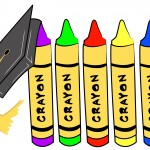
Last week, Son “graduated” from preschool. Some kids were moving on to a 5’s program so the school called it a “celebration.” Fine with me. Son received a personalized water bottle (for the beach this summer), a medal (which he covets), and a memorable description of how he will be remembered by the school (something about his curiosity, which I know all too well). Afterwards we ran out to a waiting ice cream truck in the parking lot and then went to the new Crumbs in Westport for monstrous cupcakes.
This final day of preschool found me rather weepy with a deep sense of gratitude for the caring, attentive staff; a warm, nurturing environment where I watched Son blossom from Fall to Spring; and pride in his growth and readiness for Kindergarten.
It took me some trial and error to find the right preschool. When I initially looked for a 2’s program for him, I wasn’t sure what I was looking for in a preschool. And while the 2’s program at his former school was great for him, the next year’s 3’s class wasn’t the right fit. It was too large (20 kids) and the teachers lacked the warm and fuzzy feeling Son needed in school – at three years old. When the director chided him for a trembling lip one morning as he struggled to pull on his overloaded backpack, I’d had it.
So I searched closer to home and fell in love with Norfield Children’s Center the moment I entered and met the director and teachers. They were all about warm and fuzzy. I have found in business and many institutional settings that the top down theory usually holds true. In business, a CEO centered on fiscal discipline installs this in business unit managers. Likewise, a relaxed, caring preschool director usually equals the same in the teachers.
Play or Learn?
The instinctual attraction I felt when touring the school played out all year long. I connected with Son’s teacher and watched her connect with him. This is a “play based” school and while there’s much debate about how much our kids need to learn before Kindergarten, I place high value on my children’s education in creative and physical play, social interaction, and just plain fun.
After all, what’s Kindergarten for if not learning how to read? Or is that first grade? Based on friends’ children who have already learned their phonics and are reading at age four, I’ve wondered whether to push my kids to read before Kindergarten. But I can’t help allowing our time to consist mainly of creating airplanes out of the kitchen and family room furniture, playing hide and seek, and rocking out together to the Boss.
If you happened to read Peggy Orenstein’s article, Kindergarten Cram, in The New York Times Magazine a few weeks ago, you get my drift. She cited a new report, “Crisis in the Kindergarten,” in discussing her apprehension when touring classrooms that promised nightly homework for five year olds.
As she wrote, “A survey of 254 teachers in New York and Los Angeles the group commissioned found that kindergartners spent two to three hours a day being instructed and tested in reading and math. They spent less than 30 minutes playing. “Play at age 5 is of great importance not just to intellectual but emotional, psychological social and spiritual development,” says Edward Miller, the report’s co-author.”
Why do we push our kids so early? I like that 40 is the new 30 but why does “5 have to be the new 7?”
Orenstein added “Regardless of the cause, Miller says, accelerating kindergarten is unnecessary: any early advantage fades by fourth grade. ‘It makes a parent proud to see a child learn to read at age 4, but in terms of what’s really best for the kid, it makes no difference.’”
While Son knows the alphabet and numbers and his phone number and some other essentials for Kindergarten, what his teacher, Mrs. B, focused on teaching towards the end of the year, were some skills that may serve him best as he enters elementary school.
Many mornings during the last few months of school, she would put Legos on the table for children to play with. I’ve never seen such quiet, focused attention. “It’s good for manual dexterity (the pieces are way small!) and helps them learn problem solving and negotiation,” she would tell me. If a child wanted a piece the other child was using, she would coach them on how to resolve the matter.
So, off we go this summer to the beach and the playground and the ice cream parlor and the backyard to play, play, play. And while I thought a few months ago I should probably whip out the flash cards to prep Son for the big K, I’ve decided instead to take a lesson from Mrs. B.
I think I’ll spend my parental teaching moments helping prepare him for how to deal with a big class of many kids he doesn’t know who will probably at times want to nudge or grab or hit or taunt him and maybe, just maybe, he’ll come prepared with a good sense of self and imaginative leadership that will help him excel at what five year olds should know best: How to turn the classroom – and the world – into whatever he wants it to be.
If you like this story and would like to receive my next post, enter your email here.
